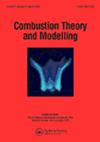Numerical modeling and parametric analysis of performance of a monopropellant thruster using a single-part catalyst bed model
IF 1.6
4区 工程技术
Q4 ENERGY & FUELS
引用次数: 0
Abstract
AbstractMonopropellant hydrazine thruster, depending on their thrust level, specific impulse, and unique functional regime, are widely used in situation control, orbital transmission, and position correction systems of satellites. In these thrusters, hydrazine decomposes by passing through the catalyst bed in a highly exothermic reaction to hot gas products. Hot gases generate thrust force by passing through a convergent-divergent nozzle. Pore scale analysis of catalytic reactions is very common in various industries and is of interest to researchers due to its accuracy. In this paper, the decomposition chamber of a monopropellant hydrazine thruster is numerically simulated with a single-part bed model at the pore-scale. The length of decomposition chamber was 2.48 cm. Then the effects of parameters such as catalyst granule diameter, catalyst bed porosity coefficient and also chamber inlet pressure on the performance of the decomposition chamber and thruster are investigated. Simulations have been performed for catalyst granules with diameters of 0.88, 1.00 and 1.15 mm in three porosity coefficients of 0.4, 0.55 and 0.65. The inlet pressure is also changed from 10 to 25 bar in four different levels. The results showed that the porosity coefficient is the most effective parameter and with its decrease, the specific impulse and temperature rise, while the thrust force and mass flow rate intensify. Also, the size of the catalyst granules affects the performance of the bed and thruster so that by increasing it (at a certain porosity coefficient), a trend similar to the effect of decreasing the porosity coefficient can be seen in the results. On the other hand, with enhancing inlet pressure, the thrust force increases significantly. In this paper, the effect of bed parameters on the thruster performance is discussed in detail, which contains helpful results for researchers that work on improving the decomposition chamber efficiency.Keywords: monopropellant thruster; catalyst bed; decomposition chamber; catalyst granule diameter; bed porosity coefficient; chamber inlet pressure; pore scale analysis Disclosure statementNo potential conflict of interest was reported by the author(s).基于单组分催化剂床模型的单推进剂推进器性能数值模拟与参数分析
摘要单推进剂联氨推进器由于其推力等级、比冲和独特的功能状态,广泛应用于卫星的态势控制、轨道传输和位置校正系统中。在这些推进器中,肼通过催化剂床分解,与热气体产物发生高度放热反应。热气体通过会聚-发散喷嘴产生推力。催化反应的孔尺度分析在各个工业中非常普遍,由于其准确性而引起了研究人员的兴趣。本文对单推进剂联氨推进器的分解室进行了孔隙尺度的单段床层模型数值模拟。分解室长度为2.48 cm。研究了催化剂粒径、催化剂床层孔隙率系数、进气压力等参数对分解室和推力器性能的影响。在孔隙率系数分别为0.4、0.55和0.65的条件下,对粒径为0.88、1.00和1.15 mm的催化剂颗粒进行了模拟。进口压力也从10到25 bar在四个不同的水平变化。结果表明:孔隙率系数是最有效的参数,随着孔隙率系数的减小,比冲和温度升高,推力和质量流量增大;此外,催化剂颗粒的大小也会影响床层和推力器的性能,因此在一定的孔隙率系数下,增加催化剂颗粒的大小可以得到与减小孔隙率系数类似的结果。另一方面,随着进口压力的增大,推力显著增大。本文详细讨论了床层参数对推力器性能的影响,为提高分解室效率的研究人员提供了有益的结果。关键词:单推进剂推进器;催化剂床;分解;催化剂粒径;床层孔隙度系数;燃烧室进口压力;披露声明作者未报告潜在的利益冲突。
本文章由计算机程序翻译,如有差异,请以英文原文为准。
求助全文
约1分钟内获得全文
求助全文
来源期刊

Combustion Theory and Modelling
工程技术-工程:化工
CiteScore
3.00
自引率
7.70%
发文量
38
审稿时长
6 months
期刊介绍:
Combustion Theory and Modelling is a leading international journal devoted to the application of mathematical modelling, numerical simulation and experimental techniques to the study of combustion. Articles can cover a wide range of topics, such as: premixed laminar flames, laminar diffusion flames, turbulent combustion, fires, chemical kinetics, pollutant formation, microgravity, materials synthesis, chemical vapour deposition, catalysis, droplet and spray combustion, detonation dynamics, thermal explosions, ignition, energetic materials and propellants, burners and engine combustion. A diverse spectrum of mathematical methods may also be used, including large scale numerical simulation, hybrid computational schemes, front tracking, adaptive mesh refinement, optimized parallel computation, asymptotic methods and singular perturbation techniques, bifurcation theory, optimization methods, dynamical systems theory, cellular automata and discrete methods and probabilistic and statistical methods. Experimental studies that employ intrusive or nonintrusive diagnostics and are published in the Journal should be closely related to theoretical issues, by highlighting fundamental theoretical questions or by providing a sound basis for comparison with theory.
 求助内容:
求助内容: 应助结果提醒方式:
应助结果提醒方式:


